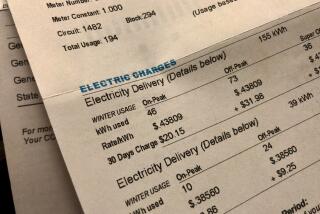Power Exchange Marketplace to Close
The Power Exchange, declared extinct Friday by its management, was both the keystone of California’s experiment with electricity deregulation and, to many, a major cause of its failure.
Since 1998, the Pasadena-based nonprofit agency was the free market in which as much as 90% of the state’s electricity was bought and sold, and where Southern California Edison and Pacific Gas & Electric purchased most of their power.
But with the price of that power surging in recent months above what the two private utilities can charge customers, the companies defaulted on payments to creditors. Sellers stayed away because they feared they would not get paid, and the two utilities were suspended from the exchange Friday.
That was the coup de grace, bringing down what was once the largest market of its kind. A mere 30,700 megawatt hours were traded Friday compared with prior loads as high as 530,000 megawatt hours.
The exchange announced it would immediately lay off 15% of its approximately 200 employees and soon go out of business. The demise of the market means anyone who wants to buy electricity will have to rely increasingly on private deals.
“The damage the markets have suffered has caused us to no longer be able to deliver the services we so well performed,” said exchange chief executive George Sladoje.
The idea behind the exchange was to create a place where marketers of power would be hooked into buyers with hourly auctions. The state required its three largest utilities--PG&E;, Edison and San Diego Gas & Electric--to buy through the exchange to prevent secret deals with wholesalers.
Emergency purchases were to be made by the California Independent System Operator, another nonprofit that would pay extra for power on days when electricity was scarce. But as the power crisis grew acute, Cal-ISO took on more of the business and the Power Exchange lost customers. And a federal order in December already allowed utilities to buy power outside the exchange or Cal-ISO.
The structure of the exchange was, to many, Exhibit A in the case against deregulation. Prices for each hour were set at the highest accepted bid, driving up the cost. Because most transactions on the exchange’s Alhambra trading floor were for the next day, the market was extremely volatile and subject to price spikes. And the public had no access to the identities of those buying and selling power.
But it had its defenders.
The Power Exchange “was the only good thing that consumers got out of deregulation,” said Mike Florio, an attorney with the Utility Reform Network, a San Francisco-based consumer group. “The PX provided a transparent market in which the small guys could purchase power as cheaply as the big guys.”
More to Read
Inside the business of entertainment
The Wide Shot brings you news, analysis and insights on everything from streaming wars to production — and what it all means for the future.
You may occasionally receive promotional content from the Los Angeles Times.










